Magnetic-Responsive Doxorubicin-Containing Materials Based on Fe3O4 Nanoparticles with a SiO2/PEG Shell and Study of Their Effects on Cancer Cell Lines
Abstract
:1. Introduction
2. Results and Discussion
2.1. Synthesis and Characterization of Nanocomposite Materials
2.2. MTT Cytotoxicity Assay
2.3. Dox Release under Exposure to AMF
3. Materials and Methods
3.1. Materials
3.2. Synthesis of MNPs with SiO2 Shell (MNPs 1)
3.3. Synthesis of MNPs@TESPSA (MNPs 2–4)
3.4. Synthesis of Conjugate 5 NMR Experiment
3.5. Synthesis of MNPs@PEG (MNPs 6–8)
3.6. Synthesis of MNPs@PEG-Dox (MNPs 9–11)
3.7. Characterization of Nanocomposites
3.8. Determination of Specific Absorption Rate (SAR) and Intrinsic Loss Power (ILP) of MNPs 6 and 9
3.9. Study of Dox Desorption from MNPs 9–11 during AMF Treatment of Their Aqueous Colloidal Solutions
3.10. Assessment of Cytotoxicity of MNPs 6 and MNPs 9
3.11. Assessment of Cytotoxicity of MNPs 6 and 9 under Application of AMF
3.12. Statistical Analysis
4. Conclusions
Supplementary Materials
Author Contributions
Funding
Institutional Review Board Statement
Informed Consent Statement
Data Availability Statement
Acknowledgments
Conflicts of Interest
References
- Salve, R.; Kumar, P.; Ngamcherdtrakul, W.; Gajbhiy, V.; Yantasee, W. Stimuli-responsive mesoporous silica nanoparticles: A custom-tailored next generation approach in cargo delivery. Mater. Sci. Eng. C 2021, 124, 112084. [Google Scholar] [CrossRef] [PubMed]
- Xi, X.; Shi, J.; Deng, Q.; Xu, N.; Huang, F.; Xiang, X. Biodegradable and self-fluorescent ditelluride-bridged mesoporous organosilica/polyethylene glycol-curcumin nanocomposite for dual-responsive drug delivery and enhanced therapy efficiency. Mater. Today Chem. 2022, 23, 100660. [Google Scholar] [CrossRef]
- Popescu, R.C.; Andronescu, E.; Vasile, B.S. Recent advances in magnetite nanoparticle functionalization for nanomedicine. Nanomaterials 2019, 9, 1791. [Google Scholar] [CrossRef]
- Demin, A.M.; Pershina, A.G.; Minin, A.S.; Brikunova, O.Y.; Murzakaev, A.M.; Perekucha, N.A.; Romashchenko, A.V.; Shevelev, O.B.; Uimin, M.A.; Byzov, I.V.; et al. Smart design of pH-responsive system based on pHLIP-modified magnetite nanoparticles for tumor MRI. ACS Appl. Mater. Interfaces 2021, 13, 36800. [Google Scholar] [CrossRef] [PubMed]
- Liu, D.; Li, J.; Wang, C.; An, L.; Lin, J.; Tian, Q.; Yang, S. Ultrasmall Fe@Fe3O4 nanoparticles as T1–T2 dual-mode MRI contrast agents for targeted tumor imaging. Nanomedicine 2021, 32, 102335. [Google Scholar] [CrossRef] [PubMed]
- Liang, P.-C.; Chen, Y.-C.; Chiang, C.-F.; Mo, L.-R.; Wei, S.-Y.; Hsieh, W.-Y.; Lin, W.-L. Doxorubicin-modified magnetic nanoparticles as a drug delivery system for magnetic resonance imaging-monitoring magnet-enhancing tumor chemotherapy. Inter. J. Nanomed. 2016, 11, 201–211. [Google Scholar] [CrossRef]
- Novoselova, M.V.; German, S.V.; Abakumova, T.O.; Perevoschikov, S.V.; Sergeeva, O.V.; Nesterchuk, M.V.; Efimova, O.I.; Petrov, K.S.; Chernyshev, V.S.; Zatsepin, T.S.; et al. Multifunctional nanostructured drug delivery carriers for cancer therapy: Multimodal imaging and ultrasound-induced drug release. Colloids Surf. B 2021, 200, 111576. [Google Scholar] [CrossRef]
- Pershina, A.G.; Brikunova, O.Y.; Demin, A.M.; Abakumov, M.A.; Vaneev, A.N.; Naumenko, V.A.; Erofeev, A.S.; Gorelkin, P.V.; Nizamov, T.R.; Muslimov, A.R.; et al. Variation in tumor pH affects pH-triggered delivery of peptide-modified magnetic nanoparticles. Nanomedicine 2021, 32, 102317. [Google Scholar] [CrossRef]
- Bulte, J.W.M. Superparamagnetic iron oxides as MPI tracers: A primer and review of early applications. Adv. Drug Deliv. Rev. 2019, 138, 293. [Google Scholar] [CrossRef]
- Yoon, H.-M.; Kang, M.-S.; Choi, G.-E.; Kim, Y.-J.; Bae, C.-H.; Yu, Y.-B.; Jeong, Y.-I. Stimuli-responsive drug delivery of doxorubicin using magnetic nanoparticle conjgated poly(ethylene glycol)-g-chitosan copolymer. Int. J. Mol. Sci. 2021, 22, 13169. [Google Scholar] [CrossRef]
- Liu, X.; Zhang, Y.; Wang, Y.; Zhu, W.; Li, G.; Ma, X.; Zhang, Y.; Chen, S.; Tiwari, S.; Shi, K.; et al. Comprehensive understanding of magnetic hyperthermia for improving antitumor therapeutic efficacy. Theranostics 2020, 10, 3793–3815. [Google Scholar] [CrossRef]
- Hervault, A.; Dunn, A.E.; Lim, M.; Boyer, C.; Mott, D.; Maenosono, S.; Thanh, N.T.K. Doxorubicin loaded dual pH- and thermoresponsive magnetic nanocarrier for combined magnetic hyperthermia and targeted controlled drug delivery applications. Nanoscale 2016, 8, 12152–12161. [Google Scholar] [CrossRef] [PubMed]
- Li, M.; Bu, W.; Ren, J.; Li, J.; Deng, L.; Gao, X.; Wang, P. Enhanced synergism of thermo-chemotherapy for liver cancer with magnetothermally responsive nanocarriers. Theranostics 2018, 8, 693–709. [Google Scholar] [CrossRef]
- Guisasola, E.; Asín, L.; Beola, L.; de la Fuente, J.M.; Baeza, A.; Vallet-Regí, M. Beyond traditional hyperthermia. In vivo cancer treatment with magnetic-responsive mesoporous silica nanocarriers. ACS Appl. Mater. Interfaces 2018, 10, 12518–12525. [Google Scholar] [CrossRef] [PubMed]
- Chen, L.; Fujisawa, N.; Takanohashi, M.; Najmina, M.; Uto, K.; Ebara, M. A Smart hyperthermia nanofiber-platform-enabled sustained release of doxorubicin and 17AAG for synergistic cancer therapy. Int. J. Mol. Sci. 2021, 22, 2542. [Google Scholar] [CrossRef]
- Zarrin, A.; Sadighian, S.; Rostamizadeh, K.; Firuzi, O.; Hamidi, M.; Mohammadi-Samani, S.; Miri, R. Design, preparation, and in vitro characterization of a trimodally-targeted nanomagnetic onco-theranostic system for cancer diagnosis and therapy. Int. J. Pharm. 2016, 500, 62–76. [Google Scholar] [CrossRef]
- Ramnandan, D.; Mokhosi, S.; Daniels, A.; Singh, M. Chitosan, polyethylene glycol and polyvinyl alcohol modified MgFe2O4 ferrite magnetic nanoparticles in doxorubicin delivery: A comparative study in vitro. Molecules 2021, 26, 3893. [Google Scholar] [CrossRef]
- Nogueira, J.; Soares, S.F.; Amorim, C.O.; Amaral, J.S.; Silva, C.; Martel, F.; Trindade, T.; Daniel-da-Silva, A.L. Magnetic driven nanocarriers for pH-responsive doxorubicin release in cancer therapy. Molecules 2020, 25, 333. [Google Scholar] [CrossRef]
- Parlanti, P.; Boni, A.; Signore, G.; Santi, M. Targeted dendrimer-coated magnetic nanoparticles for selective delivery of therapeutics in living cells. Molecules 2020, 25, 2252. [Google Scholar] [CrossRef]
- Zaaeri, F.; Khoobi, M.; Rouini, M.; Javar, H.A. pH-responsive polymer in a core–shell magnetic structure as an efficient carrier for delivery of doxorubicin to tumor cells. Int. J. Polym. Mater. Polym. Biomater. 2018, 67, 967–977. [Google Scholar] [CrossRef]
- Meng, H.; Liong, M.; Xia, T.; Li, Z.; Ji, Z.; Zink, J.I.; Nel, A.E. Engineered design of mesoporous silica nanoparticles to deliver doxorubicin and P-glycoprotein siRNA to overcome drug resistance in a cancer cell line. ACS Nano 2010, 4, 4539–4550. [Google Scholar] [CrossRef]
- Javanbakht, S.; Shadi, M.; Mohammadian, R.; Shaabani, A.; Ghorbani, M.; Rabiee, G.; Amini, M.M. Preparation of Fe3O4@SiO2@Tannic acid double core-shell magnetic nanoparticles via the Ugi multicomponent reaction strategy as a pH-responsive co-delivery of doxorubicin and methotrexate. Mater. Chem. Phys. 2020, 247, 122857. [Google Scholar] [CrossRef]
- Popescu, R.C.; Savu, D.; Dorobantu, I.; Vasile, B.S.; Hosser, H.; Boldeiu, A.; Temelie, M.; Straticiuc, M.; Iancu, D.A.; Andronescu, E.; et al. Efficient uptake and retention of iron oxide-based nanoparticles in HeLa cells leads to an effective intracellular delivery of doxorubicin. Sci. Rep. 2020, 10, 10530. [Google Scholar] [CrossRef] [PubMed]
- Schöttler, S.; Becker, G.; Winzen, S.; Steinbach, T.; Mohr, K.; Landfester, K.; Mailänder, V.; Wurm, F.R. Protein adsorption is required for stealth effect of poly(ethylene glycol)- and poly(phosphoester)-coated nanocarriers. Nat. Nanotechnol. 2016, 11, 372–377. [Google Scholar] [CrossRef]
- Demin, A.M.; Mekhaev, A.V.; Kandarakov, O.F.; Popenko, V.I.; Leonova, O.G.; Murzakaev, A.M.; Kuznetsov, D.K.; Uimin, M.A.; Minin, A.S.; Shur, V.Y.; et al. L-Lysine-modified Fe3O4 nanoparticles for magnetic cell labelling. Colloids Surf. B 2020, 190, 110879. [Google Scholar] [CrossRef]
- Demin, A.M.; Maksimovskikh, A.V.; Mekhaev, A.V.; Kuznetsov, D.K.; Minin, A.S.; Pershina, A.G.; Uimin, M.A.; Shur, V.Y.; Krasnov, V.P. Silica coating of Fe3O4 magnetic nanoparticles with PMIDA assistance to increase the surface area and enhance peptide immobilization efficiency. Ceram. Int. 2021, 47, 23078–23087. [Google Scholar] [CrossRef]
- Del Hierro, I.; Pérez, Y.; Fajardo, M. Silanization of iron oxide magnetic nanoparticles with ionic liquids based on amino acids and its application as heterogeneous catalysts for Knoevenagel condensation reactions. Mol. Catal. 2018, 450, 112–120. [Google Scholar] [CrossRef]
- Demin, A.M.; Krasnov, V.P.; Charushin, V.N. Covalent modification of surface of Fe3O4 magnetic nanoparticles with alkoxy silanes and amino acids. Mendeleev Commun. 2013, 23, 14–16. [Google Scholar] [CrossRef]
- Lei, Y.; Zhang, X.; Meng, X.; Wang, Z. The preparation of core–shell Fe3O4@SiO2 magnetic nanoparticles with different surface carboxyl densities and their application in the removal of methylene blue. Inorg. Chem. Commun. 2022, 139, 109381. [Google Scholar] [CrossRef]
- Moroşana, A.; Mihaiescu, D.E.; Istratia, D.; Voicub, G.; Radua, M.; Hanganuc, A.; Stan, R. Functionalized silica shell magnetic nanoparticles for nanophase peptide synthesis applications. Microporous Mesoporous Mater. 2019, 286, 45–56. [Google Scholar] [CrossRef]
- Mauricio, M.R.; de Barros, H.R.; Guilherme, M.R.; Radovanovic, E.; Rubira, A.F.; de Carvalho, G.M. Synthesis of highly hydrophilic magnetic nanoparticles of Fe3O4 for potential use in biologic systems. Colloids Surf. A 2013, 417, 224–229. [Google Scholar] [CrossRef]
- Barabanova, A.I.; Pryakhina, T.A.; Afanas’ev, E.S.; Zavin, B.G.; Vygodskii, Y.S.; Askadskii, A.A.; Philippova, O.E.; Khokhlov, A.R. Anhydride modified silica nanoparticles: Preparation and characterization. Appl. Surf. Sci. 2012, 258, 3168–3172. [Google Scholar] [CrossRef]
- Demin, A.M.; Vakhrushev, А.V.; Valova, M.S.; Minin, A.S.; Kuznetsov, D.K.; Uimin, M.A.; Shur, V.; Krasnov, V.P.; Charushin, V.N. Design of SiO2/aminopropylsilane-modified magnetic Fe3O4 nanoparticles for doxorubicin immobilization. Russ. Chem. Bull. 2021, 70, 987–994. [Google Scholar] [CrossRef]
- Li, S.; Zhang, Y.; He, X.-W.; Li, W.-Y.; Zhang, Y.-K. Multifunctional mesoporous silica nanoplatform based on silicon nanoparticles for targeted two-photon-excited fluorescence imaging-guided chemo/photodynamic synergetic therapy in vitro. Talanta 2020, 209, 120552. [Google Scholar] [CrossRef]
- Obaidat, I.M.; Issa, B.; Haik, Y. Magnetic properties of magnetic nanoparticles for efficient hyperthermia. Nanomaterials 2015, 5, 63–89. [Google Scholar] [CrossRef]
- Guisasola, E.; Baeza, A.; Asín, L.; de la Fuente, J.M.; Vallet-Regí, M. Heating at the nanoscale through drug-delivery devices: Fabrication and synergic effects in cancer treatment with nanoparticles. Small Methods 2018, 2, 1800007. [Google Scholar] [CrossRef]
- Cazares-Cortes, E.; Espinosa, A.; Guigner, J.-M.; Michel, A.; Griffete, N.; Wilhelm, C.; Menager, C. Doxorubicin intracellular remote release from biocompatible oligo(ethylene glycol) methyl ether methacrylate-based magnetic nanogels triggered by magnetic hyperthermia. ACS Appl. Mater. Interfaces 2021, 13, 36800. [Google Scholar] [CrossRef]
- Deka, S.R.; Quarta, A.; Di Corato, R.; Riedinger, A.; Cingolani, R.; Pellegrino, T. Magnetic nanobeads decorated by thermo-responsive PNIPAM shell as medical platforms for the efficient delivery of doxorubicin to tumour cells. Nanoscale 2011, 3, 619–629. [Google Scholar] [CrossRef]
- Griffete, N.; Fresnais, J.; Espinosa, A.; Wilhelm, C.; Bée, A.; Ménager, C. Design of magnetic molecularly imprinted polymer nanoparticles for controlled release of doxorubicin under an alternative magnetic field in athermal conditions. Nanoscale 2015, 7, 18891–18896. [Google Scholar] [CrossRef]
- Riemer, J.; Hoepken, H.H.; Czerwinska, H.; Robinson, S.R.; Dringen, R. Colorimetric ferrozine-based assay for the quantitation of iron in cultured cells. Anal. Biochem. 2004, 331, 370–375. [Google Scholar] [CrossRef]
- Mosmann, T. Rapid colorimetric assay for cellular growth and survival: Application to proliferation and cytotoxicity assays. J. Immunol. Methods 1983, 65, 55–63. [Google Scholar] [CrossRef]
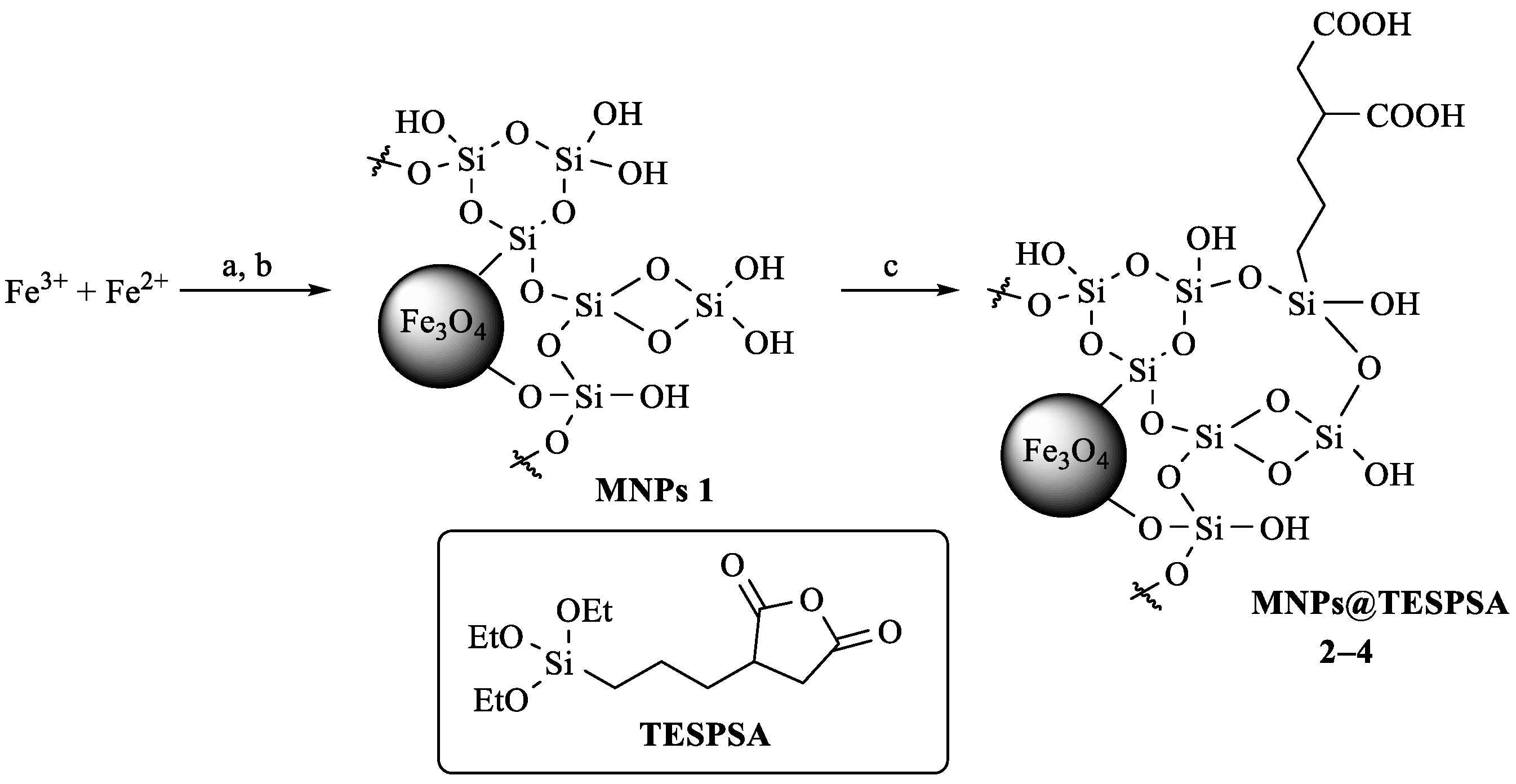
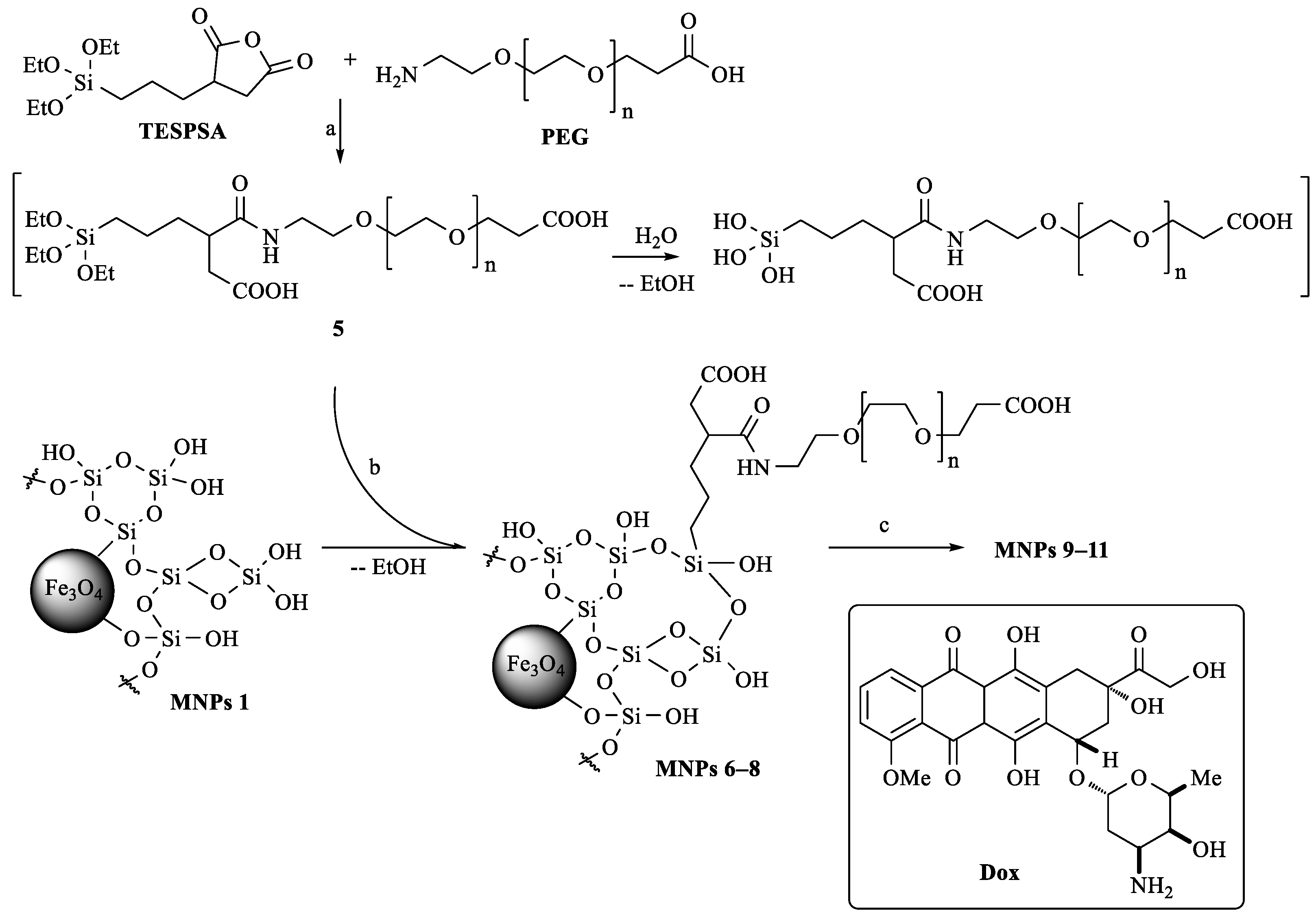
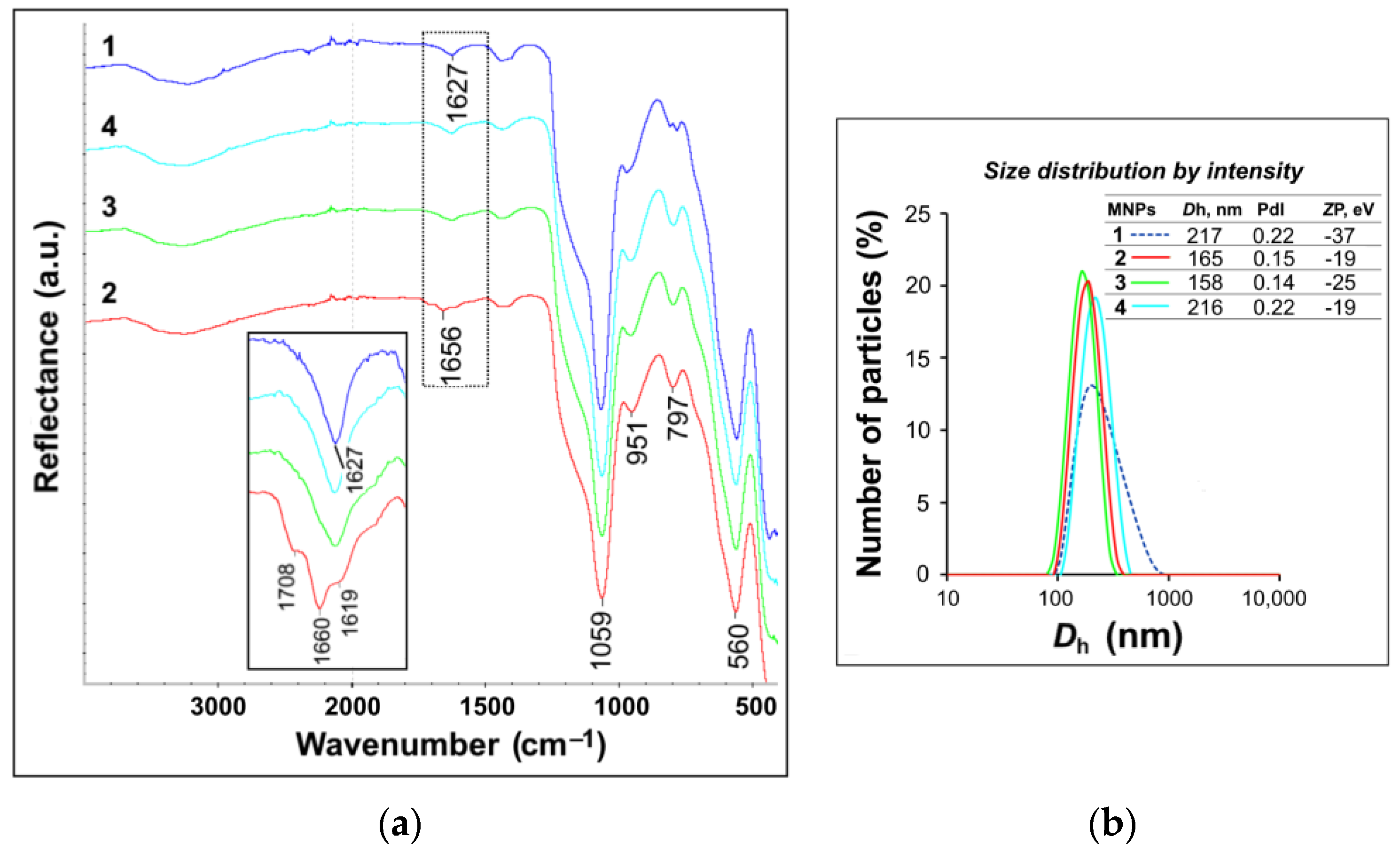
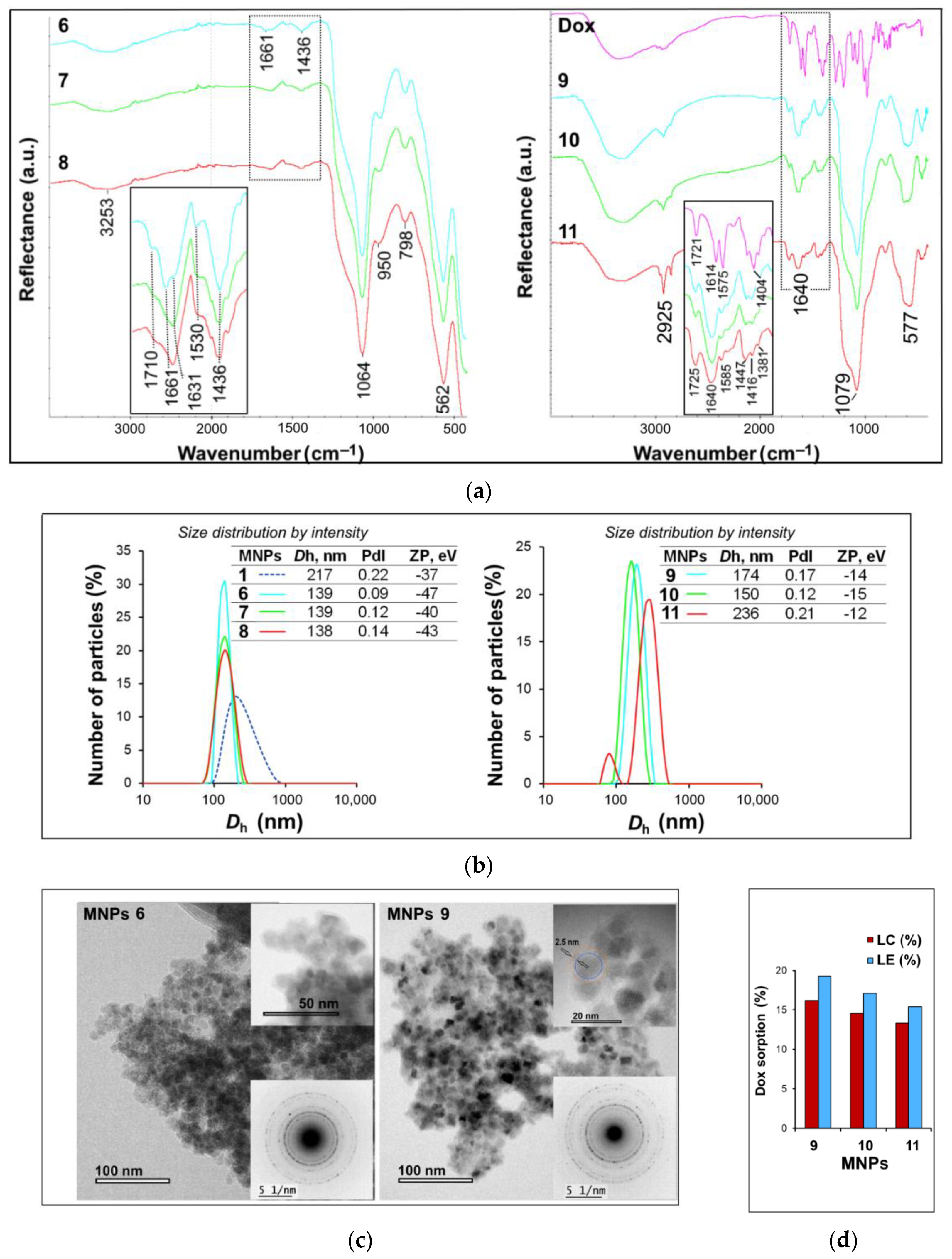
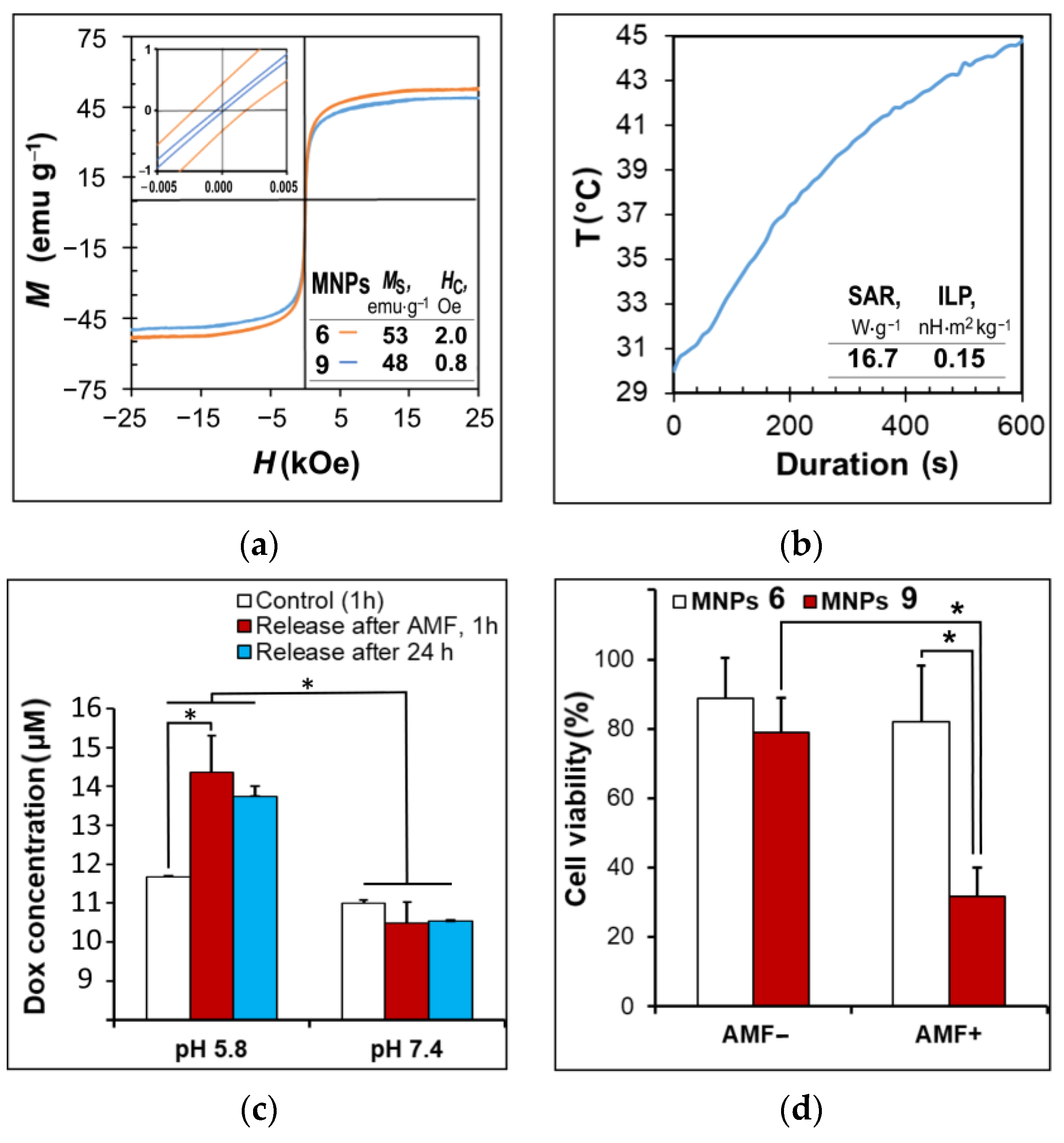
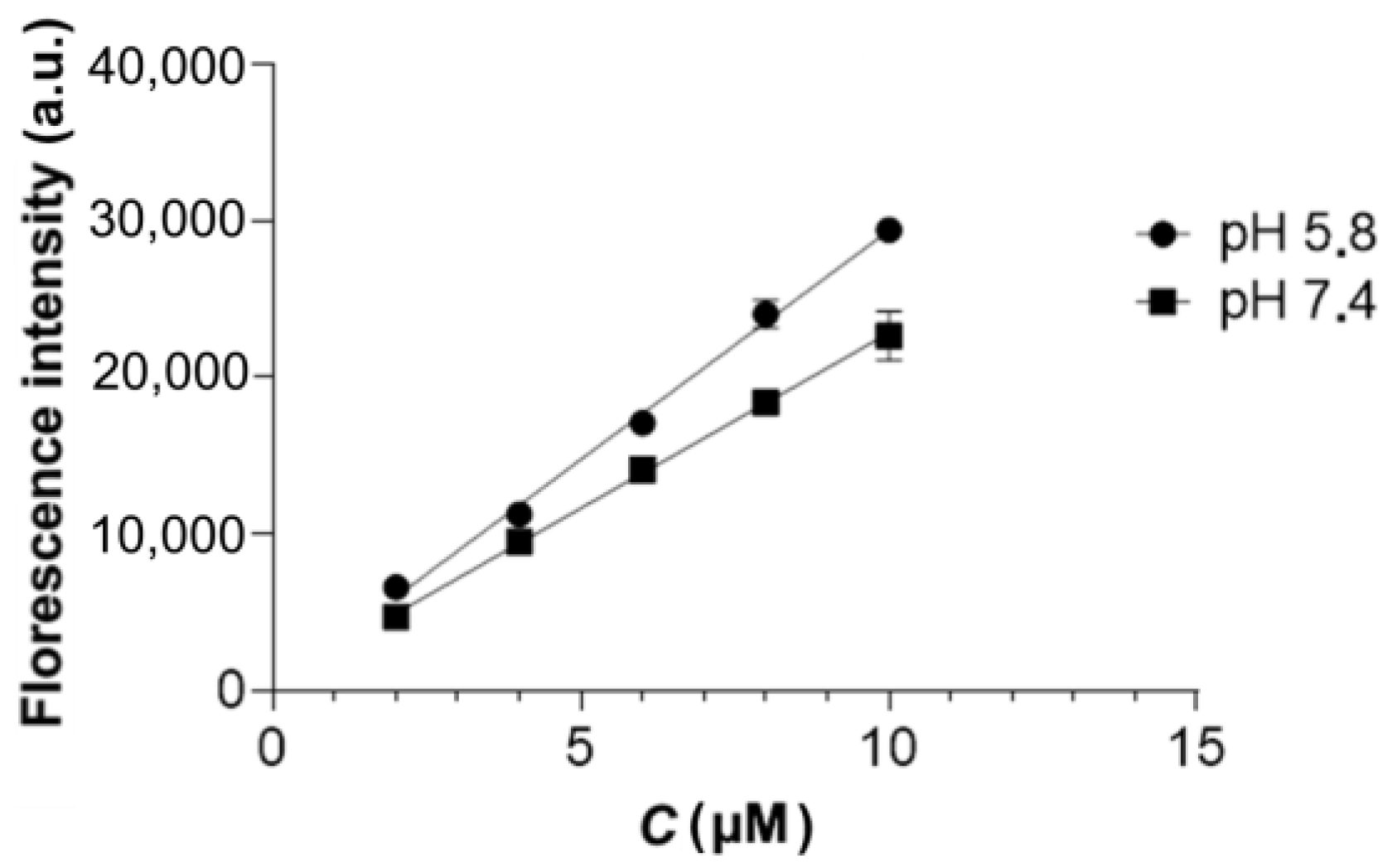
| Cell Line | Dox (µM) | MNPs 6 (µg (Fe)/mL) | MNPs 9 (µg (Fe)/mL) |
|---|---|---|---|
| 24 h | |||
| 4T1 | 2.42 ± 0.25 | 369.69 ± 436.10 | 86.14 ± 30.29 |
| MDA-MB231 | 3.81 ± 1.67 | 823.098 ± 1014.89 | 49.49 ± 21.65 |
| HepG2 | 4.06 ± 1.28 | 164.18 ± 22.00 | 33.12 ± 16.47 |
| CT26 | 10.26 ± 1.01 | 145,982.70 ± 204,396.90 | 68.10 ± 0 |
| B16 | 0.26 ± 0.058 | 1138.97 ± 1496.78 | 5.78 ± 0.42 |
| 48 h | |||
| 4T1 | 0.62 ± 0.37 | 76.24 ± 31.050 | 11.06 ± 4.46 |
| MDA-MB231 | 1.05 ± 0.09 | 715.19 ± 109.05 | 13.99 ± 4.24 |
| HepG2 | 0.33 ± 0.14 | 329.06 ± 338.59 | 5.17 ± 0.67 |
| CT26 | 0.62 ± 0.21 | 586.74 ± 311.94 | 5.21 ± 0.33 |
| B16 | 0.10 ± 0 | 63.04 ± 22.52 | 1.00 ± 0.66 |
| Active Substance | IC50 (µmol/L) | ||||
|---|---|---|---|---|---|
| 4T1 | MDA-MB231 | HepG2 | CT26 | B16 | |
| Dox | 0.62 ± 0.37 | 1.05 ± 0.09 | 0.33 ± 0.14 | 0.62 ± 0.21 | 0.10 ± 0 |
| MNPs 9 | 2.57 ± 1.04 | 3.25 ± 0.98 | 1.20 ± 0.16 | 1.21 ± 0.08 | 0.23 ± 0.15 |
Publisher’s Note: MDPI stays neutral with regard to jurisdictional claims in published maps and institutional affiliations. |
© 2022 by the authors. Licensee MDPI, Basel, Switzerland. This article is an open access article distributed under the terms and conditions of the Creative Commons Attribution (CC BY) license (https://creativecommons.org/licenses/by/4.0/).
Share and Cite
Demin, A.M.; Vakhrushev, A.V.; Pershina, A.G.; Valova, M.S.; Efimova, L.V.; Syomchina, A.A.; Uimin, M.A.; Minin, A.S.; Levit, G.L.; Krasnov, V.P.; et al. Magnetic-Responsive Doxorubicin-Containing Materials Based on Fe3O4 Nanoparticles with a SiO2/PEG Shell and Study of Their Effects on Cancer Cell Lines. Int. J. Mol. Sci. 2022, 23, 9093. https://doi.org/10.3390/ijms23169093
Demin AM, Vakhrushev AV, Pershina AG, Valova MS, Efimova LV, Syomchina AA, Uimin MA, Minin AS, Levit GL, Krasnov VP, et al. Magnetic-Responsive Doxorubicin-Containing Materials Based on Fe3O4 Nanoparticles with a SiO2/PEG Shell and Study of Their Effects on Cancer Cell Lines. International Journal of Molecular Sciences. 2022; 23(16):9093. https://doi.org/10.3390/ijms23169093
Chicago/Turabian StyleDemin, Alexander M., Alexander V. Vakhrushev, Alexandra G. Pershina, Marina S. Valova, Lina V. Efimova, Alexandra A. Syomchina, Mikhail A. Uimin, Artem S. Minin, Galina L. Levit, Victor P. Krasnov, and et al. 2022. "Magnetic-Responsive Doxorubicin-Containing Materials Based on Fe3O4 Nanoparticles with a SiO2/PEG Shell and Study of Their Effects on Cancer Cell Lines" International Journal of Molecular Sciences 23, no. 16: 9093. https://doi.org/10.3390/ijms23169093
APA StyleDemin, A. M., Vakhrushev, A. V., Pershina, A. G., Valova, M. S., Efimova, L. V., Syomchina, A. A., Uimin, M. A., Minin, A. S., Levit, G. L., Krasnov, V. P., & Charushin, V. N. (2022). Magnetic-Responsive Doxorubicin-Containing Materials Based on Fe3O4 Nanoparticles with a SiO2/PEG Shell and Study of Their Effects on Cancer Cell Lines. International Journal of Molecular Sciences, 23(16), 9093. https://doi.org/10.3390/ijms23169093







